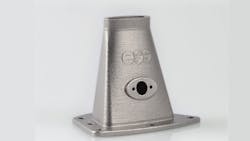Printing Nickel Alloy Parts for Critical Applications
EOS, one of the primary developers of additive manufacturing machines adaptable to producing metal parts (via laser sintering), expanded its portfolio of metal materials with a new nickel-based alloy. EOS NickelAlloy HX is a heat- and corrosion-resistant nickel-chrome-iron-molybdenum combination with a profile for high material strength and resistance to oxidization at high temperatures. It will be widely applicable for component parts that must endure temperatures up to 1,200ºC.
The material is optimized for processing in the EOSint M 280 metal system, typically in layers that are 20 µm thick. In laser sintering, the base material is deposited on to a platen in a layers with shapes defined by a CAD-derived models, and then sintered by laser application to transform the material into a metal alloy.
“The material is particularly well suited for deployment in applications that are exposed to high thermal forces giving rise to a significant risk of oxidization,” explained Christiane Krempl, the EOS marketing manager for metals. “Typical areas of deployment that we are seeing include aerospace, with combustion chambers and their component parts. The material is also ideal for use in heating elements, in conveyor ovens, or industrial blast furnaces.”
A product developer for Siemens Energy confirmed the applications for laser sintering with gas turbine products: “We use EOS’ additive manufacturing process for constructing prototypes, for ‘rapid manufacturing’ and ‘rapid repair’,” according to Andreas Graichen. “Thanks to this technology we are able to cut times and thereby reduce costs for customers commissioning us in the repair of industrial gas turbines.
“In the construction process, we use the NickelAlloy HX,” he continued. “Its material properties make it ideally suited for repair works, as it is able to withstand the high temperatures to which the gas turbines are constantly exposed. For the repair, the complete burner is brought into the tailor made EOS-Metal System: We leave the structure intact, remove the outer 20 mm, and then simply print a new combustion head. This process ensures significant savings both in terms of times and costs.”
After forming, the parts built from EOS NickelAlloy HX can be heat treated in order to partially modify the characteristics of the material. Whether hardened or in their original built form, parts can be finished as required, and surplus unexposed material can be re-used.
